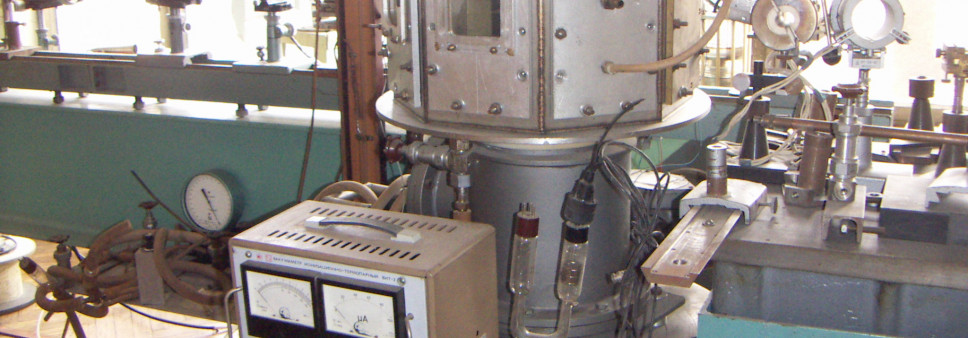Shock Wave Dynamics in Neutral Gases and Plasma
The project N11/03: Shock Wave Dynamics in Neutral Gases and Plasma won in 2011 grant competition for fundamental research. The project supervisor is Iv. Javakhishvili Tbilisi State University Professor Sulkhan Nanobashvili. The goal of the project was to study in detail the shock wave (SW) evolution and dynamics in both – neutral medium and also plasma. Project tasks were divided in two parts: 1) shock wave evolution and dynamics in neutral gases and 2) shock wave evolution and dynamics in plasma.
For accomplishment of project tasks there were created:
1) Universal Vacuum Device. In this device SW dynamics has been studied in neutral gases and also weakly ionized plasma in wide range of pressure.
2) Vacuum Device. In this device different radius ring shape SW multispark dischargers were installed. This way toroidal SW was formed and converging SW cumulation took place in the center of toroid.
3) CO2 laser complex (main discharge modules, high voltage power supply together with its control panel and bank of capacitors, working gas – CO2, He and N- mixture preparation stand etc.) has been practically assembled anew, tested and tuned.
In project accomplishment period:
1) Joint research work has been continued on tokamak COMPASS (Institute of Plasma Physics, Czech Academy of Sciences, Prague, Czech Republic) in order to develop various ultrahigh frequency diagnostic devices, perform their testing and active experiments using these devices.
As a result of experiments the following has been found:
1) It is possible to obtain reliably spherical and plane SW by means of spark discharger in low pressure conditions down to p=3 Torr.
2) When gas pressure decreases shock wave amplitude decreases and Mach number increases. At low pressure p=3 Torr, Mach number reaches M=5.2.
3) In pressure range p=1÷10 Torr plane shock wave velocity practically does not change at substantial distance (up to 30 cm) from the source.
4) Shock wave amplitude significantly decreases in plasma, while its velocity increases sharply increases by 35 %.
5) Increase of shock wave velocity in plasma takes place due to rise of temperature T=500÷600K (temperature is measured by thermocouple).
6) Decrease of shock wave amplitude in plasma is due to strong dissipation. It is also possible that this is connected also to so called isotope effect, which will be verified by forthcoming research.
7) By means of toroidal multispark discharger source unified SW is formed in reality. This SW propagates towards the center and strong cumulative effect takes place, which is accompanied by strong illumination in the central area and also ejection of strong jets perpendicular to the plane of toroid in both sirections. This effect is very similar to astrophysical jets, which gives motivation for continuation of research.
8) In the area of cumulation formation of Mach Wave is also observed.
9) In case of large diameter (d > 100 mm) multispark shock wave source use, close to the individual point of SW spark source SW front overcomes plasma and plasma does not participate in cumulative effects which take place in the central area.
The results obtained in the framework of the project were presented on 4 international conferences and symposiums. They have been also published in scientific journals:
- 2012, “Toroidal Shock Wave Dynamics Near the Area of Cumulation” In Proc. 25th Symposium on Plasma Physics and Technology SPPT 25th, Prague, Czech Republic, June 18-21, 2012. S.Nanobashvili, G.Gelashvili, M.Mdivni-shvili, I.Nanobashvili,G.Rostomashvili
- 2012, „First Results from EBW Emission Diagnostics on COMPASS" Rev. Sci. Instrum., V.83, 10E327, 2012 AIP Publishing, USA J.Zajac, J.Preinhaelter, J.Urban, S.Nanobashvili, F.Zacek et al.
- 2013 „Modernization and calibration of interferometer of TOKAMAK Compass“ IEEE,2013,s.571-575. ISBN 978-1-4799-1066-3; IEEE Publishing, USA Varavin M., Zajac J., Žáček F., Nanobashvili S. et al.
- 2013, „Possible Use of Dynamic Ergodic Divertor as a Contactless Biasing in Tokamaks“ ECA, Vol. 37D, P5.171, 2013 European Physical Society Publishing, EU I.Nanobashvili
- 2014, “Shock Wave Propagation in Neutral Gases and Weakli ionized Plasma” In Proc. 25th Symposium on Plasma Physics and Technology SPPT 26th, Prague, Czech Republic, June 16-19, 2014, S.NanobaSvili, G.GelaSvili, M. MdivniSvili, I.Nanobashvili, G.Rostomashvili, G.Tavxelidze
- 2014, „New Design of Microwave Interferometer for Tokamak COMPASS“ Telecommunications and Radio Engineering,V.73, N 10, pgs. 935-942, 2014 This journ. consists of transl. from two Russian journ.: Ele-ktrosvyaz' and Radiotekhnik. Publisher J.Wiley, USA Varavin M., Zajac J., Žáček F., Nanobashvili S. et al.
- 2014, „Investigation of Intermittent Burst Characteristics for Bwttwr Understending of Plasma Turbulent Transport in Tokamaks“ Plasma Physics and Technology, V.1, №1, p.26, 2014 Czech Technical University in Prague, Czech Republic I.Nanobashvili
- 2014, „Shock Wave Propagation in Neutral Gases and Weakly Ionized Plasma“ Plasma Physics and Technology, V.1, №2, p.93, 2014 Czech Technical University in Prague, Czech Republic S.Nanobashvili, G.Gelashvili, M.Mdivnishvili,I.Nanobashvili, G. Rostomashvili, G.Tavkhelidze










